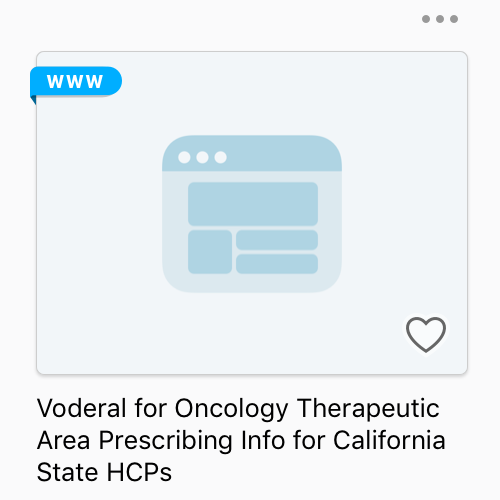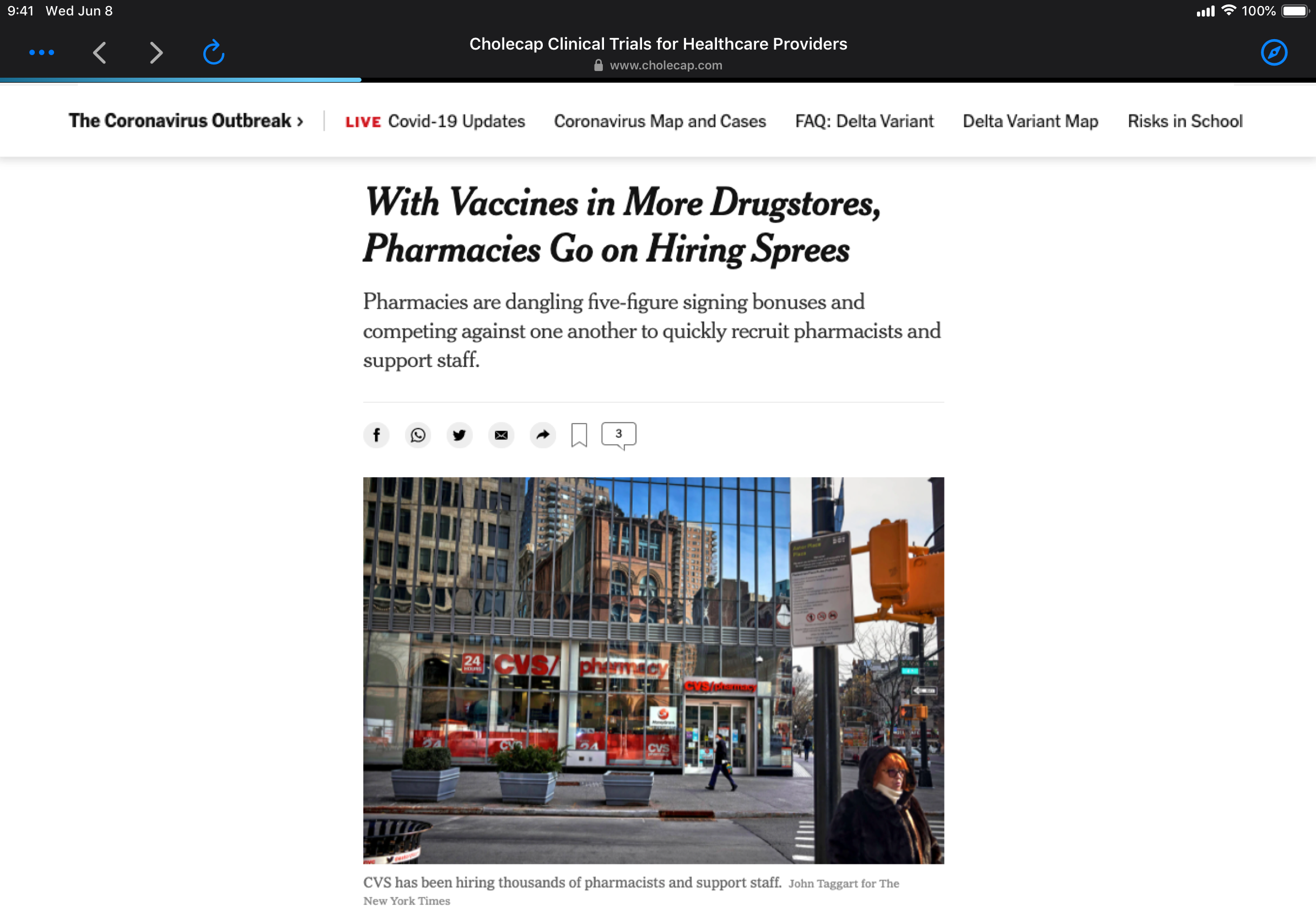Displaying Website Content in the Media Library
- iPad
- iPhone
Veeva CRM supports displaying website content in the media library. Content creators can create websites with approved content which users can share with HCPs during calls and Engage meetings, while ensuring the content is compliant.

Considerations
- Restricted products, allowed products, and segmentations for accounts are respected and control which websites users can display to each account
- The CLM_ENABLE_AUTO_LAUNCH_vod Veeva Setting is ignored to allow users to display websites in the embedded web browser
Configuring Websites
Ensure initial configuration is complete before enabling this functionality.
To configure website content:
- Grant content creators FLS edit permission to the URL_vod field on the Key_Message_vod object.
- Grant end users FLS read permission to the URL_vod field on the Key_Message_vod object.
- Ensure content creators have access to tabs for the following objects:
- CLM_Presentation_vod
- CLM_Presentation_Slide_vod
- Key_Message_vod
Creating and Managing Website Content in Vault PromoMats/MedComms
Content creators can create and manage website content as binders and slides in Vault PromoMats/MedComms. Website content then syncs to CRM as part of the CLM integration with Vault.
Veeva recommends managing website content in Vault PromoMats/MedComms instead of managing it directly in CRM.
To create website content in Vault PromoMats/MedComms:
- Add the website__v Shared Field to the Multichannel Slide document type.
- Navigate to Business Admin > Objects > Websites.
- Create a website__v record with the following information:
- URL – The URL for the website content. Tokens can be appended to the URL for activity tracking. See Adding Tracking Tokens to Website URLs for more information about supported tokens.
- Status – Active
- Distribution Channel – CRM
Object lifecycles are not supported for the website__v object.
- Create a Multichannel Presentation.
- Create a Multichannel Slide in the Multichannel Presentation binder. A binder for a website must only contain one slide.
- Populate the website__v field in the Engage Properties section on the slide with the newly created website__v record.
- Upload a distribution package to the slide. The distribution package is a zip file containing a folder with the following thumbnail assets:
Type
Naming Convention
Resolution (in pixels)
Poster
<filename>-full.jpg (for example, verteo-full.jpg)
1024 x 768
Thumbnail
<filename>-thumb.jpg (for example, verteo-thumb.jpg)
200 x 150
Ensure the name of the folder matches the filename in the thumbnail assets. For example, if the thumbnail is named Verteo-thumb.jpg, the zip file must be named Verteo.zip.
- Select Yes for the Publish to Veeva CRM (CLM) field to allow the binder to sync to CRM.
- Select Yes for the Publish to Veeva CRM (Weblink) field to allow end users to share the website content via social messaging apps.
- Select Save.
Creating Website Content in CRM
To create website content, create the following records with the following fields:
- CLM_Presentation_vod
- Description_vod
- Keywords_vod
- Status_vod – This field must be set to Approved for the website to display as available to end users
CLM_Presentation_vod records for websites are not supported as sub-presentations.
- Key_Message_vod
- Active_vod – This check box must be selected
- Description_vod
- URL_vod – The URL of the website. The Websites tab in the media library displays when users have visibility to this field. Tokens can be appended to the URL for activity tracking. See Adding Tracking Tokens to Website URLs for more information about supported tokens.
Key_Message_vod records for websites are not supported as shared resources or required slides.
- CLM_Presentation_Slide_vod
- CLM_Presentation_vod – Populate with the newly created CLM_Presentation_vod record
- Display_Order_vod
- Key_Message_vod – Populate with the newly created Key_Message_vod record
For a website, there must only be one Key_Message_vod and one CLM_Presentation_Slide_vod record per CLM_Presentation_vod record.
Content creators cannot use the gotoSlide or launchSelector functions in CLM content to launch websites from other presentations.
Defining Website Thumbnails
Admins can define website thumbnails for website content. The thumbnails display in the Websites tab of the media library.
- The WWW label displays on thumbnails to indicate the content is a website
- If a thumbnail is not defined for a website, the default thumbnail displays
- The default thumbnail cannot be changed

To define a thumbnail for a website to display in the media library:
- Create a folder containing only the following assets:
Type
Naming Convention
Resolution (in pixels)
Poster
<filename>-full.jpg
1024 x 768
Thumbnail
<filename>-thumb.jpg
200 x 150
- Ensure the name of the folder matches the filename in the thumbnail assets. For example, if the thumbnail is named Verteo-thumb.jpg, the zip file must be named Verteo.zip.
- Compress the folder into a zip file.
- Navigate to the appropriate Key_Message_vod record.
- Select Upload in the Media File section.
- Upload the zip file.
Alternatively, admins can upload the zip file using FTP. See Uploading CLM Content Using FTP for more information.
Displaying Websites in the Media Library
Websites display in the Websites tab in the media library.
To display a website, navigate to the Websites tab in the media library and select the appropriate website thumbnail. The website displays in the embedded browser. When displaying a website, users can navigate within the website or launch the website in Safari using the Safari button in the top right corner.

Users can also perform the following actions from the More Actions menu or when exiting the embedded browser:
- Done – Exit the embedded browser. Users can select an account to save the website activity for tracking, save the activity for later, or discard the activity.
Website activity only tracks how long the user displays a website in the browser. Navigation within the browser is not tracked.
- Find Media – Navigate to another website or a CLM presentation. The media library displays in an overlay. Select Close to exit the overlay.
- Select Account – Select an account to create a call and save the website activity for tracking. A list of available accounts displays. If the SELECT_CLM_CALL_RECORD_TYPE_vod Multichannel Setting is enabled, users must select the call record type after selecting the account.
- Save for Later – Save the website activity for tracking and exit the embedded browser without selecting an account. Users can associate the activity with an account later.

Displaying Websites During Calls and Engage Meetings
Users can display websites in the embedded browser during calls and Engage meetings.
To display a website during a call or an Engage meeting:
- Select the Media button on the call report.
- Navigate to the Websites tab.
- Select the appropriate website.
To share websites linked to PDF content during Engage meetings, admins must enable Host Screen Sharing on the iPad.
Websites displayed during calls or Engage meetings are tracked on the call report, similar to CLM presentations. See Tracking CLM Key Messages for more information.
Users cannot select reactions while displaying a website in the embedded browser. Users must exit the embedded browser, navigate to the Key Messages section of the call report, and select the appropriate value for the Reaction_vod field of the website key message. See Using Key Messages on the Call Report for more information.
Customers with Engage licenses can allow users to share website links with HCPs using social messaging apps. See Sharing Websites via Web Link or QR Code® for more information.



